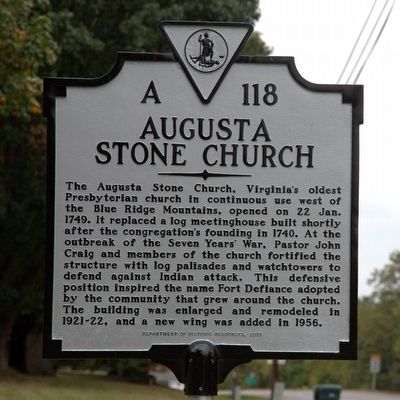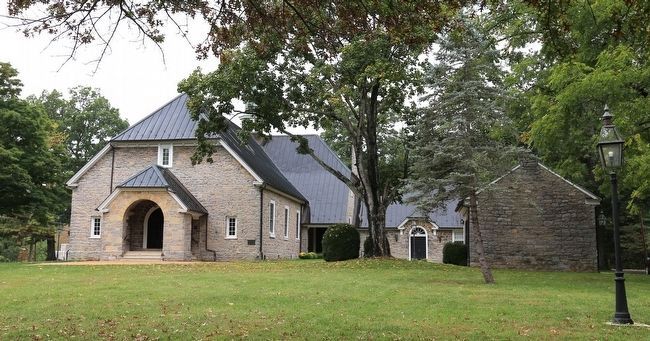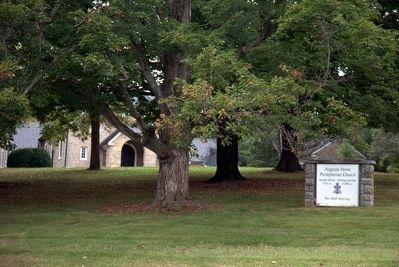Fort Defiance in Augusta County, Virginia — The American South (Mid-Atlantic)
Augusta Stone Church
American Presbyterian and Reformed Historical Site
Erected 2015 by Department of Historic Resources. (Marker Number A-118.)
Topics and series. This historical marker is listed in these topic lists: Churches & Religion • Wars, US Indian. In addition, it is included in the American Presbyterian and Reformed Historic Sites, and the Virginia Department of Historic Resources (DHR) series lists. A significant historical year for this entry is 1740.
Location. 38° 14.293′ N, 78° 58.46′ W. Marker is in Fort Defiance, Virginia, in Augusta County. Marker is on Lee Highway (U.S. 11) just south of County Route 616, on the right when traveling south. Touch for map. Marker is in this post office area: Fort Defiance VA 24437, United States of America. Touch for directions.
Other nearby markers. At least 8 other markers are within walking distance of this marker. The Rev. John Craig (within shouting distance of this marker); a different marker also named Augusta Stone Church (within shouting distance of this marker); Augusta Military Academy (approx. 0.2 miles away); Quarles Walk (approx. 0.2 miles away); This 1886 Bell (approx. 0.2 miles away); Augusta Military Academy Museum (approx. 0.2 miles away); a different marker also named Augusta Military Academy (approx. 0.2 miles away); Dwight D. Eisenhower Visits Augusta Military Academy (approx. 0.2 miles away). Touch for a list and map of all markers in Fort Defiance.
Regarding Augusta Stone Church. Augusta Stone Church was listed in the National Register of Historic Places in 1973. This church is also one of 445 American Presbyterian and Reformed Historical Sites registered between 1973 and 2003 by the Presbyterian Historical Society (PHS), headquartered in Philadelphia. Approved sites received a metal plaque featuring John Calvin’s seal and the site’s registry number (PHS marker location unknown).
The following text is taken from the Presbyterian Historical Society website:
In 1747, under the leadership of Rev. John Craig, the Augusta congregation began building the Stone Church, a religious sanctuary and a fort for early settlers. It is the oldest Presbyterian house of worship in continuous use in Virginia. The community around the church was called Fort Defiance in honor of the steadfast and brave Presbyterian settlers. The building was first remodeled in 1855 to accommodate a growing congregation and the increased enrollment of the Augusta Military Academy, whose students worshipped in the church since the beginning of the academy. The small stone Session House, originally attached, was rebuilt adjacent to the church in 1847. The Session House was converted into a museum of church heirlooms in 1975.
Also see . . .
1. Augusta Stone Presbyterian Church History. “In 1755, after Braddock's defeat, the Valley settlers were most vulnerable to attack by the Indians. Many were in favor of fleeing to the safety of eastern Virginia, but the Rev. Craig persuaded them to hold fast and to build a stockade around the church. Although the Indians never actually attacked the church, the small congregation frequently fled to Stone Church for protection when the alarm was spread that the Indians were on the warpath. Legend has it that the name Fort Defiance derives from the steadfastness and bravery demonstrated by these early Presbyterian settlers.” (Submitted on September 27, 2015.)
2. Marker Dedication Press Release. (Submitted on September 27, 2015.)
3. Augusta Stone Church NRHP Nomination page. (Submitted on August 20, 2018, by Douglass Halvorsen of Klamath Falls, Oregon.)
Credits. This page was last revised on July 3, 2021. It was originally submitted on September 27, 2015. This page has been viewed 989 times since then and 79 times this year. Last updated on August 30, 2020, by Bradley Owen of Morgantown, West Virginia. Photos: 1, 2, 3, 4. submitted on September 27, 2015, by J. J. Prats of Powell, Ohio. • J. Makali Bruton was the editor who published this page.



